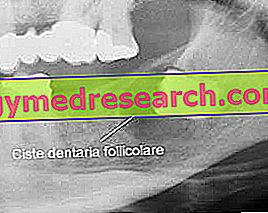Dental cyst: definition
Glossary- Dental pulp: the most internal part of the tooth, richly nourished by nerve endings, arterioles, venules and cells used for the production of dentin
- Dental follicle: embryonic structure from which the tooth originates
- Pulp necrosis: death of the pulp tissue
- Dental root: section of the tooth inserted into the alveolar bone, inside which the dental pulp is contained
- Apex of a root: point from which nerves and blood vessels access the tooth
- Root canal: canaliculus within the root, in which nerve fibers and blood vessels flow

The dental cyst is a well-circumscribed pathological cavity, normally provided with a covering epithelium and stuffed with serous, mucous or gaseous fluid.
Uncoated dental cysts (without capsules) are called pseudocysts, while those filled with pus are considered dental abscesses.
Very similar to granuloma, the dental cyst is a typical complication of pulp necrosis, in turn induced by trauma, deep caries or pulpits. There are numerous variants of dental cysts, distinct both on the basis of the nature of the content and the precise location from which they originate.
Classification
In general, cysts can be cataloged in:
- Dental radicular cysts
- Follicular cysts
- Paradistarian cysts
To simplify the analysis and facilitate the understanding of the disorder, the table shows the general characteristics of the main variants of dental cysts. Remember, however, that there are many other different classification criteria for cysts: below, only the most common types are highlighted.
| Dental cyst | Most common variants | Brief general description |
| Radicular or periapical dental cysts |
|
|
 | ||
| Follicular dental cysts |
|
|
 | ||
| _ |
|
 | ||
Causes
Together with granuloma and abscess, dental cysts are probably the most common complication of pulpitis, an inflammatory process that affects the dental pulp.
However, a dental cyst can also form under different circumstances, as follows:
- Dental inclusion
- Unsuccessful devitalization intervention
- Poor tooth extraction
- Complication of dental granulomas
Symptoms
It is not uncommon for a dental cyst to be diagnosed by chance, through a simple radiographic dental check. In fact, cysts - especially if small in size - are rather subtle and equivocal dental lesions, since they do not generally produce any symptoms.
When the dental cyst reaches a considerable size, the patient may experience more or less intense toothache. The symptomatic profile of the patient affected by dental cysts can be completed by other clinical evidences such as: swelling of a mandibular / maxillary bone section (in correspondence with the cyst), swollen gums, lip swelling, halitosis and, sometimes, tooth mobility.
Care
Before proceeding with any treatment for dental cysts, it is necessary - as well as essential - the differential diagnosis with similar pathologies (eg dental granuloma, abscess) and, above all, with tumor growths. To differentiate a benign dental cyst from a tumor, a biopsy is required, which is an invasive diagnostic test that involves the removal of a tissue flap for subsequent histological examination in the laboratory.
A suspicion of a dental cyst must be ascertained by specific radiographs, such as orthopantomography (panoramic radiography of the dental arches).
When the cyst causes toothache, its extension is most likely particularly severe, so it is necessary to intervene promptly with a more or less invasive procedure.
Given the countless variations, treatment for dental cysts is not standard and depends on the location in which they originate, the severity of the lesion and the nature of the cystic content. In general, some cysts require surgical removal, while others can simply be drained.
Also the apicectomy is an intervention particularly indicated for the removal of cystic masses at the root apex. In the most serious cases, however, the removal of the tooth is required.
After having surgically treated the dental cyst, it is strongly recommended to undergo periodic radiographic checks and reminders, in order to avoid (or anticipate) any possible recurrent forms.



